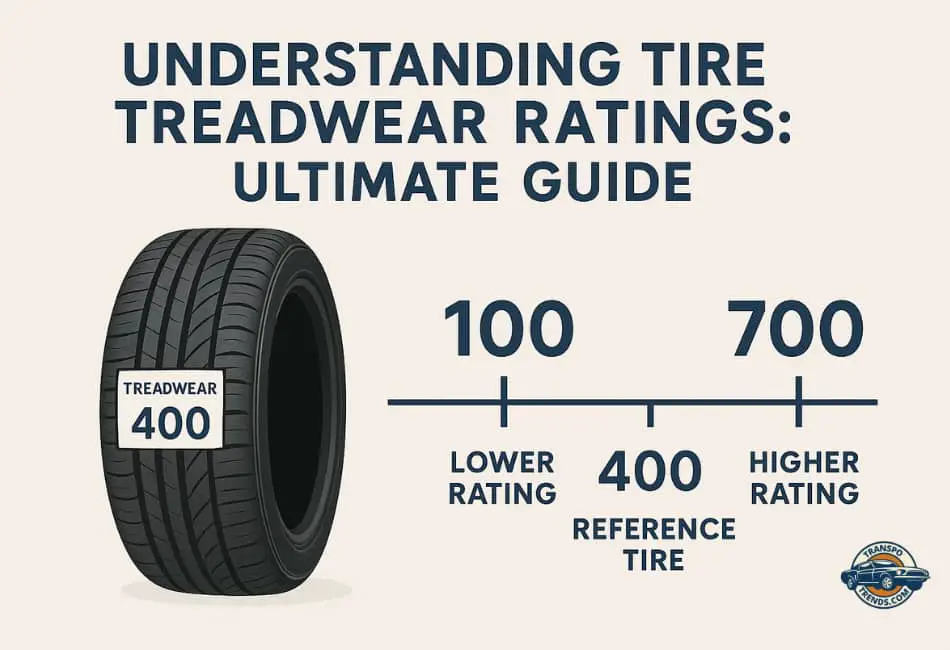Tire treadwear ratings are part of the UTQG system, which rates tires on treadwear, traction, and temperature resistance.
The treadwear rating is a three-digit number comparing a tire’s wear to a reference tire (rated at 100).
For example, a rating of 200 suggests the tire should last twice as long as the reference under similar conditions.
Tire Treadwear Ratings
Tires are a critical component of any vehicle, influencing safety, fuel efficiency, and ride comfort. When selecting new tires, understanding their ratings can alleviate the stress of choice and ensure you make an informed decision.
One key rating system is the Uniform Tire Quality Grading (UTQG), which provides standardized information on treadwear, traction, and temperature resistance.
This guide focuses on treadwear ratings, explaining what they mean and how they help compare tire longevity, offering peace of mind and potential cost savings for car owners.
What is the UTQG System?
The UTQG system, developed by the US Department of Transportation (DOT), aims to standardize tire performance ratings for consumer comparison. It evaluates tires in three areas:
- Treadwear: A numerical value indicating expected wear life relative to a reference tire.
- Traction: A letter grade (A, B, or C) for stopping ability on wet pavement.
- Temperature: A letter grade (A, B, or C) for resistance to heat buildup at high speeds.
Our focus here is the treadwear rating, which is particularly relevant for assessing how long a tire might last compared to others.
The reference tire is rated at 100, so a tire with a rating of 200 is expected to last twice as long under similar conditions.
However, it’s crucial to note that these ratings stem from controlled tests and may not reflect real-world driving, where factors like aggressive driving or rough roads can alter outcomes.
How Treadwear Ratings Are Determined
Tire manufacturers submit their products for testing by independent laboratories accredited by the National Highway Traffic Safety Administration (NHTSA). The process involves:
- Mounting tires on standard vehicles.
- Driving them over a specified government test course.
- Measuring the wear rate compared to a reference tire, set at 100 for each test run.
For instance, if a test tire wears out at half the rate of the reference, it receives a rating of 200. These tests occur under controlled conditions, such as smooth roads at consistent speeds, which may not mirror your daily commute with potholes or speed bumps.
Additionally, the reference tire can vary between test batches, potentially leading to slight differences in ratings over time, though these are generally considered negligible for comparison purposes.
To visualize, imagine a race where all tires start equal, but some wear down faster than others under the same track conditions.
The slower-wearing tires get higher ratings, but remember, this race doesn’t account for the uneven terrain you might face daily.
Interpreting Treadwear Ratings
Higher treadwear numbers generally indicate better wear resistance, suggesting the tire will last longer. However, comparisons must be apples-to-apples: compare ratings within similar categories, such as all-season versus all-season tires, not all-season versus high-performance summer tires.
For example, a performance tire might have a lower rating (e.g., 200) but offer superior handling, prioritizing grip over longevity, which suits enthusiasts differently than daily commuters.
Rough estimates suggest a rating of 100 might correspond to 20,000–30,000 miles for an average car under normal conditions, so a 200 rating could imply 40,000–60,000 miles.
Yet, these are general guidelines, and actual mileage varies widely based on driving habits, vehicle weight, and maintenance.
For instance, highway driving tends to be gentler on tires than city driving with frequent stops, and trucks may wear tires faster due to heavier loads.
Finding Your Tire’s UTQG Rating
The UTQG rating is typically found on the tire’s sidewall, alongside other details like size, load index, and speed rating.
It appears as three digits followed by two letters (e.g., 400 AA), where the digits are the treadwear rating, the first letter is traction, and the second is temperature resistance.
For new tires, this information is clear; for used ones, wear might obscure markings. If buying online, reputable retailers list these specifications, making it easier to compare options from home.
Limitations of UTQG Ratings
While useful, the UTQG system has limitations that can affect its real-world applicability:
- Test Conditions: Controlled environments don’t account for variables like potholes, speed bumps, or extreme weather, which can accelerate wear.
- Tire Type: Different tires (e.g., all-season, off-road) are designed for varied purposes, and standardized tests may not capture these differences fully.
- Driver Behavior: Aggressive driving, frequent braking, and heavy loads can wear tires faster than ratings suggest.
- Maintenance: Proper inflation, rotation, and alignment are crucial for maximizing lifespan, regardless of rating.
For example, a tire with a high treadwear rating might still wear out quickly if you frequently drive on rough roads without maintaining proper pressure. This highlights the importance of not relying solely on ratings but considering your specific driving context.
Other Factors Affecting Tire Longevity
To maximize your tire’s lifespan, consider these practical tips:
- Inflation: Check tire pressure regularly and adjust to manufacturer recommendations to prevent uneven wear.
- Rotation: Rotate tires as per the schedule (e.g., every 6,000–8,000 miles) to ensure even wear across all tires.
- Alignment: Have wheels aligned periodically to avoid uneven wear caused by misalignment.
- Driving Habits: Avoid sudden starts, stops, and turns, which can cause rapid wear.
- Road Conditions: Be cautious on rough roads and try to avoid hitting curbs or potholes, which can damage tread.
Conclusion
Tire treadwear ratings through the UTQG system offer valuable insights into potential longevity, but they’re just one piece of the puzzle.
As a consumer, consider your specific needs, driving habits, and maintenance practices to make informed decisions.
Higher ratings suggest longer life within similar categories, but real-world performance depends on many factors.
Summary: Treadwear Ratings and Interpretations
| Treadwear Rating | Interpretation (Relative to Reference) | Rough Mileage Estimate (Under Ideal Conditions) |
|---|---|---|
| 100 | Lasts as long as reference tire | 20,000–30,000 miles |
| 200 | Lasts twice as long as reference | 40,000–60,000 miles |
| 400 | Lasts four times as long as reference | 80,000–120,000 miles |

